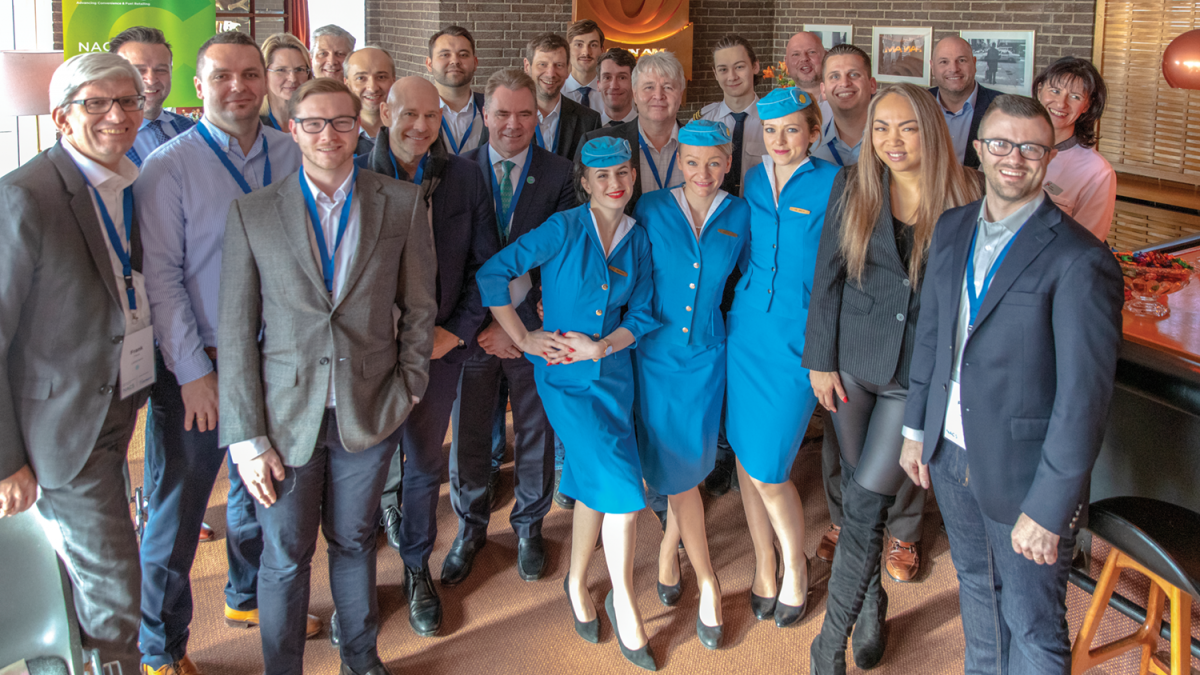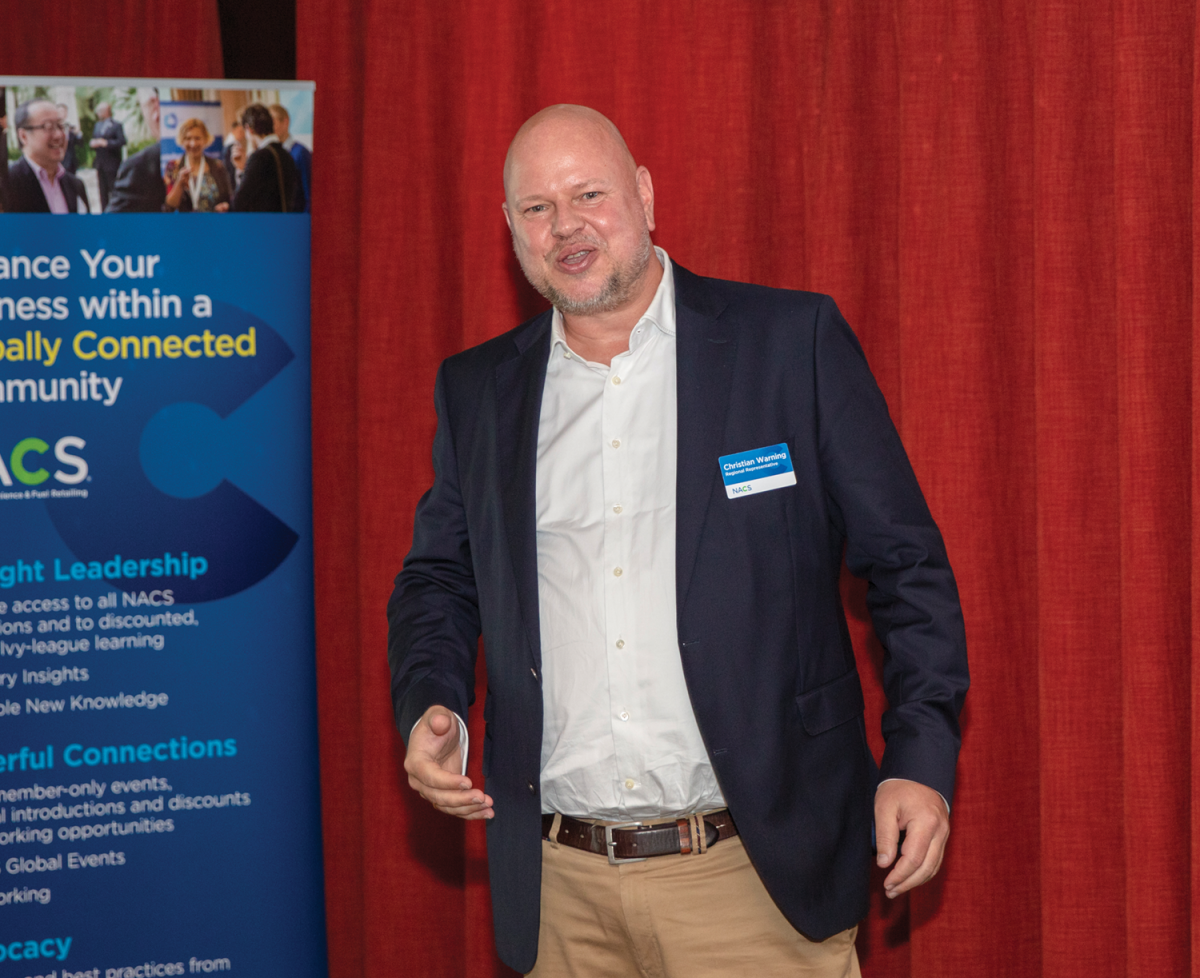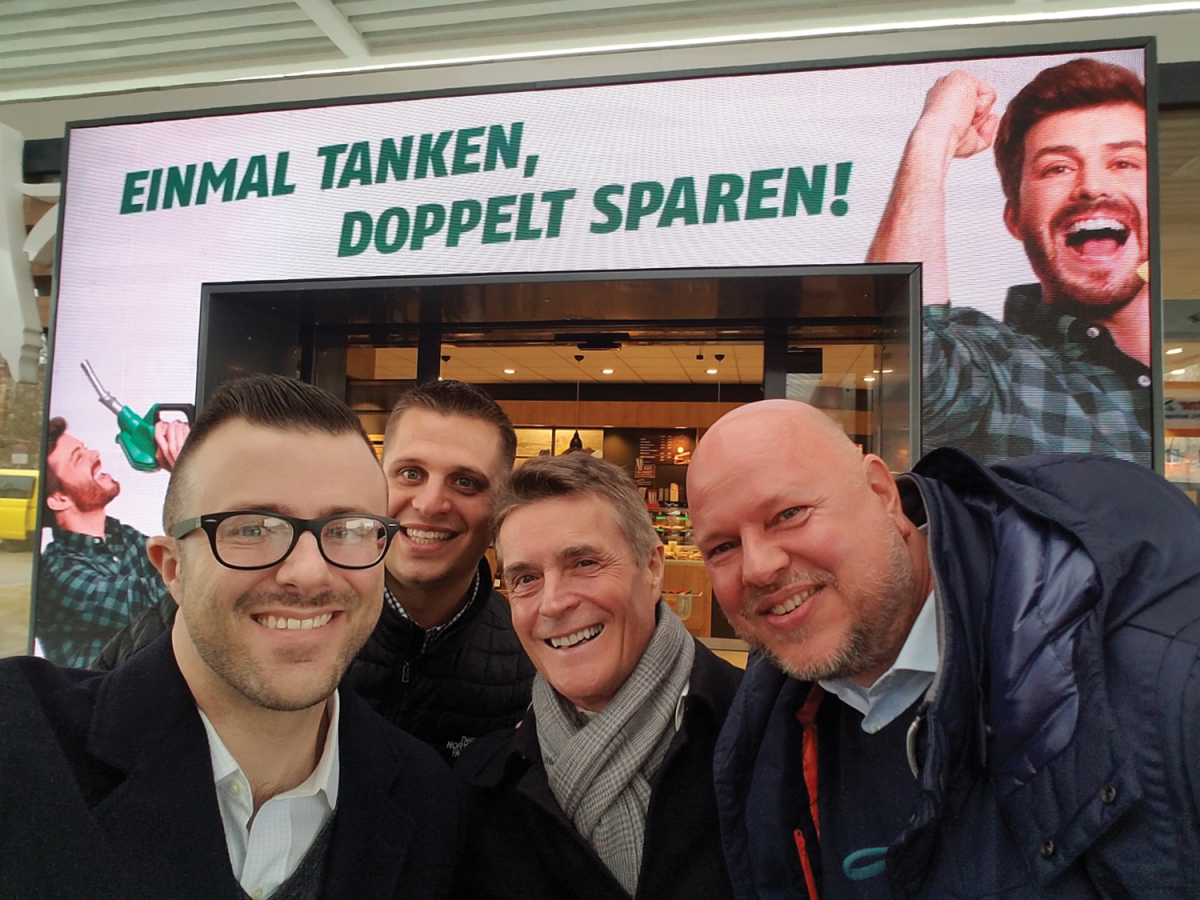The future is already here—it’s just not evenly distributed.”
NACS CEO Henry Armour shared this William Gibson quote at the NACS Regional Roundtable DACH (Germany, Austria, Switzerland) in late January. It is a great way to think about disruption. Across the globe, the convenience and fuel retailing industry experiences many of the same trends and issues—only the life cycles are further along in some places.
Interested in the future of mobile payments? It is happening right now in Japan and China. What about natural gas for automobiles? Start with Argentina. For those focused on better-for-you foodservice, a visit to Western Europe yields valuable insights.
 Roundtable attendees networked in the Pan Am Lounge, which once was the Berlin home to the pilots and stewardesses of the American airline Pan Am.
Roundtable attendees networked in the Pan Am Lounge, which once was the Berlin home to the pilots and stewardesses of the American airline Pan Am.
This is why NACS International has come to play a vital and global industry role. When leaders everywhere are connected through networking, advocacy and knowledge-sharing, everyone benefits.
Regional events are a key component of the NACS international strategy. The NACS Regional Roundtable DACH is an invitation-only event organized by NACS regional representative Christian Warning, founder and director of Retail Marketeers. Attendees gathered at the historic PanAm Lounge in Berlin, Germany, for a full day of education sessions, roundtables and networking. The event was sponsored by Petrosoft.
Find Opportunity in Disruption
Disruption is a term that strikes fear into many, conjuring images of liquidation signs and empty stores, but as Armour explained during his opening remarks, it’s important not to let your thinking become too “disrupted.”
“We’ve always had dramatic changes driven by new technologies,” he said. “There’s always someone who wins and always someone who loses. It resets the table, and many times it’s an opportunity to grow and be more successful than you were. But you have to do it differently.”
Hema believes that convenience exists online, while experiences reside inside the store.
Consider the Chinese grocer Hema, a concept of e-commerce giant Alibaba. Armour shared that Hema is an example of how retail’s future is likely to feature a blending of the digital and physical, rather than a battle between the two.
Hema’s stores are essentially distribution centers with a retail wrap. As Armour recalled from a visit to Hema offices, the company believes that convenience exists online, while experiences reside inside the store. By meeting the need for convenient grocery delivery—customers within a three-kilometer radius can get deliveries within 30 minutes—and rethinking how to build an experience that resonates with those who have a desire to shop, Hema may have struck a winning formula.
It has also learned valuable lessons. Since customers hesitated to order produce online because of fears about quality, Hema decided to save the best and most attractive fruit and vegetables for delivery. Customers adjusted in about six months.
Similarly, some delivery customers worried about expiration dates. That is why if you purchase milk at Hema, the brand name on the container is the day of the week. Visit on a Thursday, and you are buying Thursday Milk. Steep discounts in the evening help remove extra product.
For convenience retailers, Armour sees an opportunity to become the pivot between e-commerce and bricks-and-mortar. Convenience retail is already close to its customers, and it is well-positioned to be the last-mile solution, whether functioning as the collection point or the distribution point.
Mats Danielsen, CEO of Liquid Barcodes, also shared examples of how retailers can blend the physical and digital. Just as some car washes have moved to a subscription model, why not do the same for coffee? Using a mobile app, consumers can skip the checkout line by scanning a barcode at the coffee island. Many frequent customers may find this convenient. Each scan could also trigger in-app follow-up content, such as a food promotion for the next visit.
But as Armour mentioned, forward-thinking retailers would be wise to adopt a similar attitude as Altoona, Pennsylvania-based Sheetz when considering the future. As the company states on its website, its goal is to “create the business that will put Sheetz, as we know it today, out of business.”
Tomorrow’s Store, Solid Foundation
Retailers must succeed at the basics—cleanliness, safety, hospitality—before investing in higher level strategies. Fail at those primal needs, and you will fail to reach your potential.
Although the back-to-basics message has been around as a best practice for many years, additional data continue to emerge to support it. Consider GasBuddy’s 2018 Foot Traffic Report. By pairing location data and GasBuddy’s in-app consumer ratings, the report found strong correlations between customer experience and consumer visits. “At the beginning of the year, retailers are setting strategies on how they can grow 3%, 5%,” said Mike Zahajko, vice president of sales at CAF Outdoor Cleaning, who spoke at the event. “Data show the basics of retail can have an impact of 15 to 20% or more,” he added.
 NACS Regional Representative and Director/founder of Retail Marketeers Christian Warning co-hosted the Roundtable.
NACS Regional Representative and Director/founder of Retail Marketeers Christian Warning co-hosted the Roundtable.
As the industry moves forward to build the store of tomorrow, a foundation of basic needs is essential. Consider one station: Oil and trash in the forecourt, crumbling concrete with cigarette butts littered around the doors, a restroom that badly needed cleaned—and yet, a brand new, touchscreen bean-to-cup coffee machine sat on the counter. This is a great higher level strategy, but it will never live up to its full potential with such a lackluster experience around it.
The leading cross-channel competitors understand this. Few of us would ever encounter a Starbucks that looks like this store. McDonald’s, for example, announced last year that it is investing $6 billion on “Experience of the Future” remodels across the United States.
As one Summit attendee mentioned, cross-channel competition is the top issue for his company—or as he put it, the “relative relevance” of fuel and convenience. Several artisan bakeries and grocers across Berlin embrace this: Innovative designs, high-end bean-to-cup coffee machines, sandwiches and bread can be as visually appealing as they are tasty. One McDonald’s location in Germany boasts of industrial decor inspired by old Berlin Wall graffiti. There, modern furniture entices customers to enjoy their espresso in a porcelain cup, with a stroopwafel placed on the side.
It is a challenge for sure. Whether in Germany, the United States or elsewhere, disruptive innovators and cross-channel competition have given customers many choices, so they can avoid the retailers that are dirty, boring and unexceptional.
To test and ensure a positive customer experience, Zahajko encouraged leadership to experience their stores as customers do. What do they see, what do they hear, and—perhaps most importantly—what do they say about the experience? When they leave written reviews, are you listening? “When you do site visits,” said Zahajko, “whatever you fail to notice will become the new accepted norm.”
On an international level, NACS helps our members to connect and learn—and by that, to help advance our entire industry.
Evolving Consumer Preferences
NACS international events provide access to notable industry leaders around the world. What issues are on their radar, what challenges are they facing and what solutions have they deployed in their own businesses?
Consider NACS Chairman Frank Gleeson, who also spoke at the Roundtable. As the president of Aramark’s Northern Europe operations, he works with a large number of convenience stores across hospitals, universities, stadiums and more. Gleeson shared his perspective on several industry issues. “We’re going to go through quite a bit of change in fuel,” he said, discussing the growth of mobile fueling technology. “Not just the type of fuel but how fuel is delivered.”
Autonomous vehicles also will make an impact—yet how and when remains uncertain. As Gleeson explained, the technology may come to taxis and other transportation services first. Similarly, electric vehicles are likely to gain the most traction in densely populated urban environments. Recently announced, Ireland’s An Post, a state-owned provider of postal services, plans to purchase 750 electric vehicles by 2022. Deliveries in central Dublin are projected to be 100% electric by the end of 2019.
Beyond the forecourt, consumer tastes are changing inside the store. As Gleeson pointed out, his teenage daughter won’t consume sugary drinks. “She’s very careful around the types of food she eats. She’s been educated to a new level around food that I’ve never seen in my time,” he said. “I think we’re going to see more of that as we move forward. Not just athletes, but everybody’s interested in healthy eating. Convenience is being redefined.”
 Roundtable attendees took time out to visit some local innovative retailers in Berlin.
Roundtable attendees took time out to visit some local innovative retailers in Berlin.
Gleeson argues that food is a big driver of this convenience challenge. Retailers who aren’t serious about it should be—and not just with baseline packaged options. “It’s about taking on more complexity around food and certainly trying to deal with those healthier choices, the more customized solutions. That’s really what the newer generations are going to want,” he said. “If you want to take a step change, you should consider that step change as quickly as you can.”
Some of the answers may come from unconventional sources. After realizing that many of Aramark’s customers at a major corporation were venturing outside to purchase street food for lunch, Gleeson’s team brought the street food idea into one store and set up a counter. “We rotated concepts in pretty much every day. If it worked really well, we left it on as a guest item for a month. If that worked really well, we put it in as a permanent fixture,” he said. “Our team probably has 50 concepts on the go at any given time.”
Get Involved
While thought leadership and new ideas abound, the best part of any NACS International event is the conversation that happens after the presentations—the networking and candid conversation from industry leaders about how we all can move forward.
“NACS is all about knowledge, connections and advocacy,” said Mark Wohltmann, director of NACS Europe. “On an international level, we help our members to connect and learn—and by that, to help advance our entire industry. We offer the senior leadership of our global suppliers and retailers the platforms to network and to share best practices and thought leadership.”
Visit www.convenience.org/international for more information about NACS international initiatives.